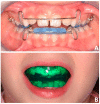Comparative Analysis of Skeletal Changes, Occlusal Changes, and Palatal Morphology in Children with Mild Class III Malocclusion Treated with Elastodontic Appliances and Bimaxillary Plates
- PMID: 37508716
- PMCID: PMC10377802
- DOI: 10.3390/children10071219
Comparative Analysis of Skeletal Changes, Occlusal Changes, and Palatal Morphology in Children with Mild Class III Malocclusion Treated with Elastodontic Appliances and Bimaxillary Plates
Abstract
Background: The aim of the present study was to compare the changes observed in children after the early treatment of mild class III malocclusion using bimaxillary removable plates supported by class III elastics and elastodontic devices.
Methods: Twenty children (mean age 7.6 ± 1.1 years) with signs of class III malocclusion were treated using by-maxillary plates (PG group) with class III elastics (10 subjects = mean age 7.9 ± 1.3 years) or using class III elastodontic devices (EG group) (10 subjects = mean age 7.4 ± 0.8 years). Digital models and lateral cephalograms were obtained before treatment (T0) and at the end of treatment (T1). The digital models were analyzed to assess occlusal changes and maxillary morphology using the surface-to-surface matching technique. Changes in cephalometric parameters were also analyzed. The data outcomes were statistically analyzed using the paired Student's t test for inter-timing assessments and the independent Student's t test for inter-group assessments.
Results: Both groups showed correction of class III malocclusions, with a significant increase in the ANB angle and the overjet (p < 0.05). Subjects in the PG group exhibited a greater reduction in the inter-incisal angle compared to the EG group (p < 0.05). The children in the EG group had a significantly lower percentage of palatal morphology matching between T0 and T1 compared to the PG group (p < 0.05), suggesting greater morphological changes in the palate.
Conclusions: Elastodontic appliances (EAs) and bi-maxillary plates successfully correct class III malocclusions in children. However, elastodontic devices significantly improved the morphology of the palate, both in the transverse and anteroposterior directions.
Keywords: children; class III malocclusion; digital orthodontics; early treatment; interceptive orthodontics.
Conflict of interest statement
The authors declare no conflict of interest.
Figures





Similar articles
-
New Materials for Orthodontic Interceptive Treatment in Primary to Late Mixed Dentition. A Retrospective Study Using Elastodontic Devices.Materials (Basel). 2021 Mar 30;14(7):1695. doi: 10.3390/ma14071695. Materials (Basel). 2021. PMID: 33808257 Free PMC article.
-
Palatal changes after treatment of functional posterior cross-bite using elastodontic appliances: a 3D imaging study using deviation analysis and surface-to-surface matching technique.BMC Oral Health. 2023 Feb 2;23(1):68. doi: 10.1186/s12903-023-02731-7. BMC Oral Health. 2023. PMID: 36732751 Free PMC article.
-
Digital analysis of the occlusal changes and palatal morphology using elastodontic devices. A prospective clinical study including Class II subjects in mixed dentition.Eur J Paediatr Dent. 2022 Dec;23(4):275-280. doi: 10.23804/ejpd.2022.23.04.04. Eur J Paediatr Dent. 2022. PMID: 36511914
-
One phase or two phase orthodontic treatment for Class II division 1 malocclusion ?Evid Based Dent. 2019 Sep;20(3):72-73. doi: 10.1038/s41432-019-0049-y. Evid Based Dent. 2019. PMID: 31562403 Review.
-
Effectiveness of Elastodontic Devices for Correcting Sagittal Malocclusions in Mixed Dentition Patients: A Scoping Review.Dent J (Basel). 2024 Aug 2;12(8):247. doi: 10.3390/dj12080247. Dent J (Basel). 2024. PMID: 39195091 Free PMC article.
Cited by
-
Preformed Elastodontic Appliances: Awareness and Attitude of Orthodontists and General Dental Practitioners.Children (Basel). 2024 Apr 1;11(4):418. doi: 10.3390/children11040418. Children (Basel). 2024. PMID: 38671635 Free PMC article.
-
Effects of AMCOP® Elastodontic Devices on Skeletal Divergence and Airway Dimensions in Growing Patients.J Clin Med. 2025 Jul 27;14(15):5297. doi: 10.3390/jcm14155297. J Clin Med. 2025. PMID: 40806919 Free PMC article.
-
Elastodontic Appliances for the Interception of Malocclusion in Children: A Systematic Narrative Hybrid Review.Children (Basel). 2023 Nov 17;10(11):1821. doi: 10.3390/children10111821. Children (Basel). 2023. PMID: 38002912 Free PMC article. Review.
-
Mechanical characterization and structural analysis of elastodontic appliances under intraoral and artificial aging conditions.BMC Oral Health. 2024 Nov 1;24(1):1337. doi: 10.1186/s12903-024-05101-z. BMC Oral Health. 2024. PMID: 39487402 Free PMC article.
-
Influence of Shortened Tongue Frenulum on Tongue Mobility, Speech and Occlusion.J Clin Med. 2023 Nov 29;12(23):7415. doi: 10.3390/jcm12237415. J Clin Med. 2023. PMID: 38068467 Free PMC article.
References
-
- Grippaudo M.M., Quinzi V., Manai A., Paolantonio E.G., Valente F., La Torre G., Marzo G. Orthodontic treatment need and timing: Assessment of evolutive malocclusion conditions and associated risk factors. Eur. J. Paediatr. Dent. 2020;21:203–208. - PubMed
-
- Schneider-Moser U., Moser L., Bennett J. Atypical treatment of Class II malocclusion with space closure only in the lower arch. Prog. Orthod. 2005;6:188–205. - PubMed
LinkOut - more resources
Full Text Sources

